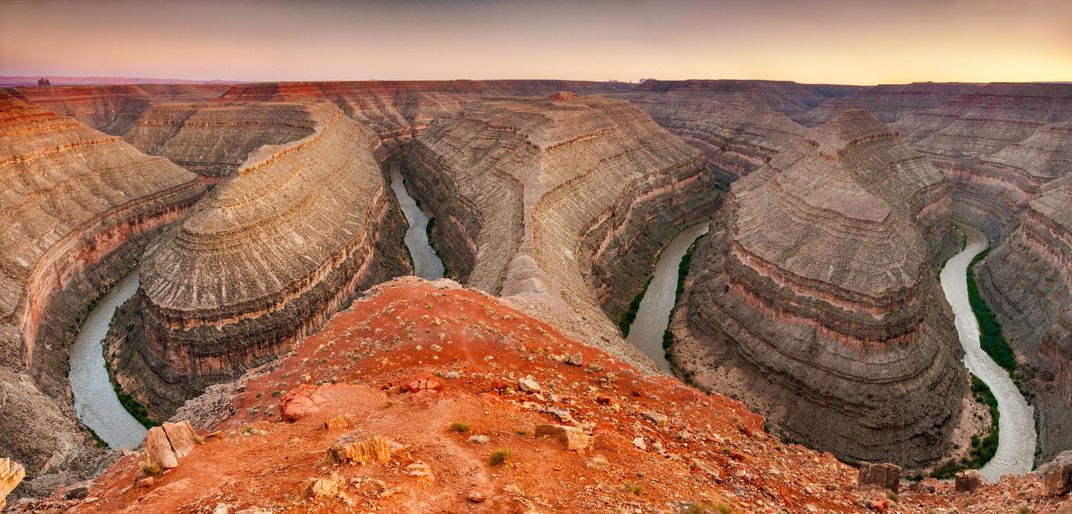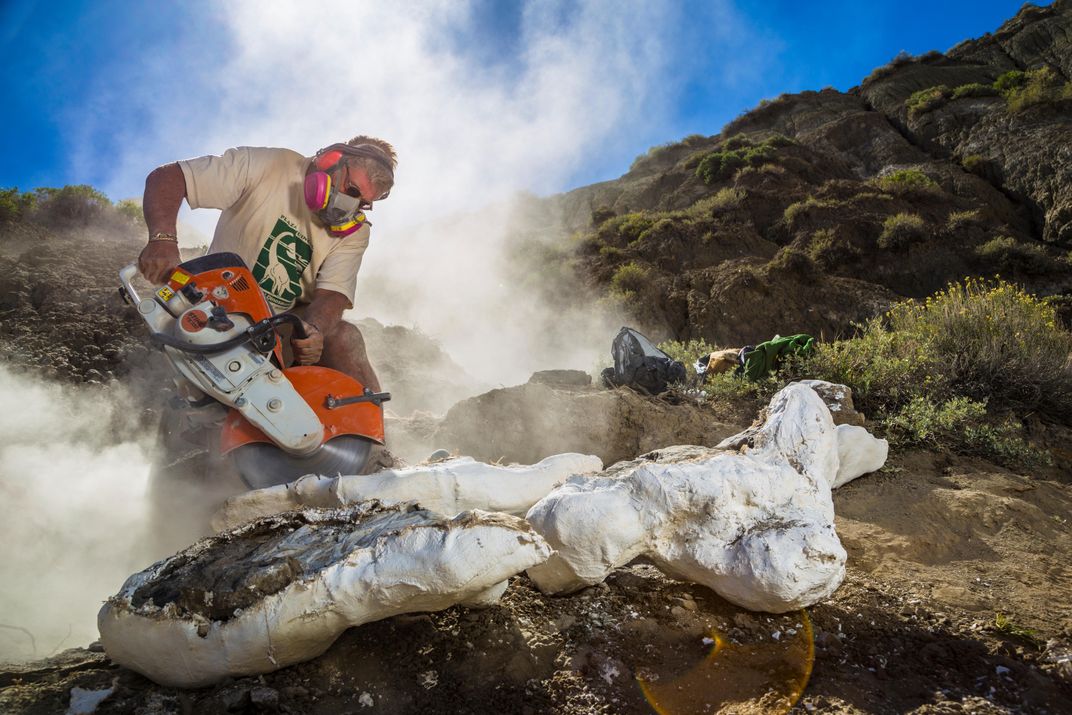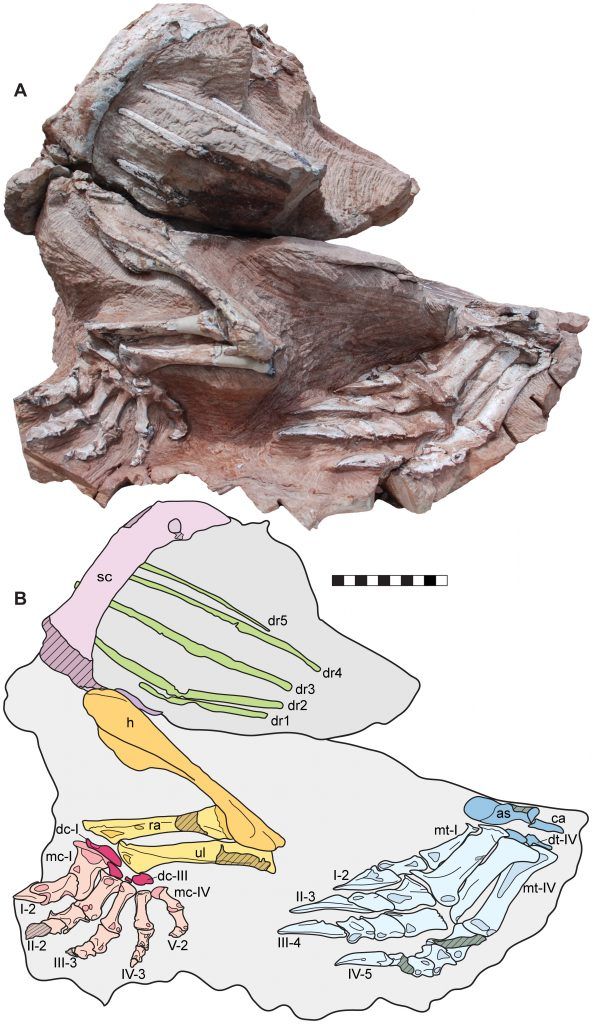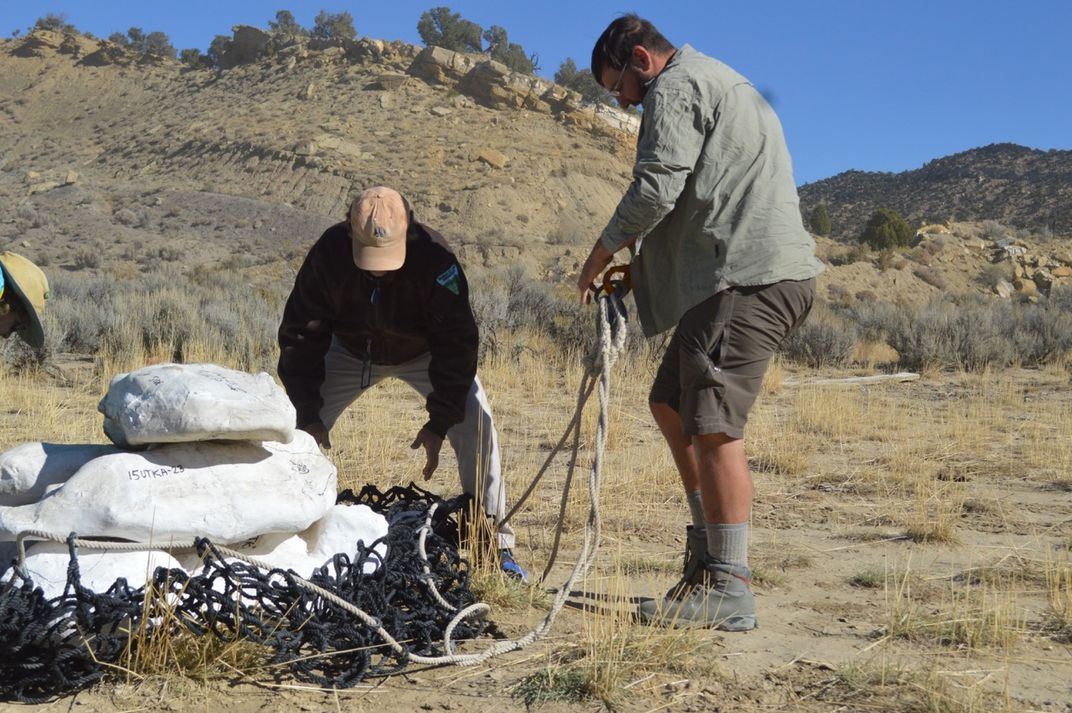What Shrinking Fossil-Rich National Monuments Means for Science
Smithsonian.com asks paleontologists how their work will change after the decision to slash Bears Ears and Grand Staircase
/https://tf-cmsv2-smithsonianmag-media.s3.amazonaws.com/filer/16/54/165472c7-82e3-4c1c-8511-10c32a83b245/d9y6mk.jpg)
Earlier this month, President Donald Trump announced the dramatic rollback of protections for roughly two million acres of land in national monuments of southern Utah, stating that the creation of these parks “lock[s] up hundreds of millions of acres of land and water under strict government control." Speaking from the state’s capitol in Salt Lake City, Trump then signed two proclamations. One slashed the 1.35 million-acres that comprise Bears Ears National Monument by 85 percent, while another cut the 1.9 million-acre Grand Staircase-Escalante national monument nearly in half.
The move was met with immediate pushback from Native American groups, wildlife conservation organizations, and even the outdoor supplier Patagonia, many of whom announced their intentions to file lawsuits. Yet joining this flurry of suits was one organization that many may not have expected: the Society of Vertebrate Paleontology (SVP), a scientific organization that comprises more than 2,300 members from universities and scientific institutions around the world. What was a society that describes itself as “organized exclusively for educational and scientific purposes” doing suing the federal government?
Both Bears Ears and Grand Staircase were created—at least in part—on the grounds of paleontological importance. In just the last decade, researchers in Grand Staircase have found and described more than 25 new taxa that were totally new to science—including Utahceratops and Kosmoceratops, the unusual relatives of the frill-faced Triceratops. "Grand Staircase especially is jaw-droppingly important in vertebrate paleontology,” says David Polly, paleontologist at Indiana University Bloomington and president of SVP. “It's completely transformed the way we think about [not only] the Late Cretaceous but other parts of the Mesozoic."
Though Bears Ears is a newer monument, created in 2016 by then-President Barack Obama, it's already proving to have great scientific potential. Earlier this year researchers announced the discovery of Utah's only known Pravusuchus hortus, an ancient crocodile-like marine reptile, within its bounds. The monument captures an "incredible record" of dinosaurs transitioning from "wimpy little nothing components of the ecosystems to being these huge, world-beating mega important parts of the global ecosystem," says Robert Gay, a vertebrate paleontologist who conducts research in association with the Museums of Western Colorado.
Countless more finds surely reside within both monuments' original bounds. But researchers fear that without the current federal protections, they may be in danger of disappearing. "These things have been lying in the ground for 75 million years, and there aren't anymore being created. If we lose the resource, it's gone forever—period. It's gone," says Robin O'Keefe, a paleontologist at Marshall University who conducts research in Grand Staircase. "We can get coal other places; we can't get these fossils anywhere else."
Smithsonian.com spoke with five scientists about how loss of this "strict government control" could harm not only conservation and paleontology research—but the nation’s history and legacy itself.

How Monument Status Protects Landscapes
The idea of designating sites as national monuments dates back to the 1906 Antiquities Act, which empowered the president to protect these sites for public use. Today, national monument status comes with far more than a pretty plaque: It both helps beef up protections against fossil looting and prioritizes scientific activities. The new proclamations would convert vast swaths of land to Federal multi-use land, bringing the potential for natural resource extraction—including oil and gas—and other activities that could impact the ancient relics still hidden within the sweeping landscape.
The importance of making these sites accessible to scientists goes beyond the work of a few people conducting research in the site, says Andrew Farke, a paleontologist with the Raymond M. Alf Museum of Paleontology. "I think a lot of times, it's pitted as scientists versus everyone else, or extreme conservationists versus everyone else," he says. "When you have a loss of protection for fossils, it's not just a loss for science. It's a loss for all Americans. This is part of our country's story; this is part of our planet's story."
Bears Ears and Grand Staircase were both, at least in part, created in recognition of their potential to help researchers better understand the geologic past. That means that currently, scientists are given priority in the monument bounds. This is far from the case on general public land, explains O'Keefe. Land managed by the federal Bureau of Land Management is technically available for all to use—but when natural resource extraction companies secure a permit for a particular site, "the fences go up, the roads go in and we [the scientists] no longer really have access," says O'Keefe.
Even if he secures the necessary permits, he adds, it's no guarantee that he will be able to gain access. He recounts several times that he was threatened by ranchers whose cattle were grazing in the region of interest. "We can go out there, but I don't want to take my life in my hands to do my job," says O'keefe.
In most cases, monuments also have the funding for more staff members, including park rangers and even on-site scientists. This means more eyes on the ground to prevent looting by private collectors and fossil hunters—"which exist and are rapacious," says O'Keefe. One of the primary motivating factors for the creation of Bears Ears was the rallying of five Native American groups—who are all now part of a lawsuit for returned protections—to prevent the pillaging of the region's vast cultural and archaeological sites.
That concern also extends to scientifically valuable fossils. "The first-ever discovery of Pravusuchus [in Utah] was by a looter," says Gay, who has done extensive work in the region of Bears Ears. The looter, a past volunteer at a southwestern Natural History Museum, found and removed the skull of the crocodile-esque creature sometime in the 1990s, which prevented scientists from ID-ing the specimen. In 2008, the individual decided to return the skull, which allowed for the first documentation of these creatures in Utah, presented this year at SVP's annual meeting.
But it's likely not all similar stories have such a happy end. As Gay says: "Who knows what sort of sites like this looted site are still out there?"
Monument status also establishes additional funding streams to support and promote scientific research within its boundaries, everything from surveying to logistical support like helicopter lifts. Gay can attest to the impacts of this funding. He worked in an area within Bears Ears before it gained monument status. "Almost as soon as the monument was proclaimed, I was informed that there was money available to help the BLM better understand and manage the resources there," he says. Within a few months, he applied and received a grant of $25,000 to work at Bears Ears.
At Grand Staircase, the funding also supports an on-site paleontologist, who is the force behind surveying the landscape and reaching out to specialists to establish collaborations and deeper research. "Having that person in place there for the monument lands, means that things happen much more smoothly, much more quickly," says Farke. "You have someone that's really overseeing just that little parcel of field work, versus having to oversee all of the federal lands in Utah."

Protections Lost
Utah’s national monuments consist of an impressive array of features—postcard-perfect vistas, precipitous cliffs and winding canyons, all highlighted by brilliant red rocks. And each monument is home to its own unique collection of valuable artifacts and natural wonders. Under the newly proposed boundaries, however, at least 400 paleontological sites in Grand Staircase alone now fall outside the monument, Polly tells Smithsonian.com.
"And there's almost certainly more," he adds, explaining that exact localities must remain confidential to prevent looting.
In collaboration with the Grand Staircase-Escalante Partners and Conservation Lands Foundations, SVP has filed a lawsuit in pursuit of returned protections to Grand Staircase. In a second lawsuit, SVP collaborated with Native American, archaeological, conservation and historic preservation organizations to restore protections to Bears Ears.
"Not only do we believe that key paleo resources will be endangered when they are removed from the monuments’ boundaries, but we believe that the President lacks the legal authority to reduce those boundaries," according to an SVP statement on the lawsuit. This argument echos other recent suits filed against the move: While the Antiquities Act empowers the president to create national monuments, it does not specifically state that he or she can reduce their borders. Instead, it included the vague requirement that monuments must be limited “to the smallest area compatible with proper care and management of the objects to be protected."
The reduction is "potentially damaging [to] the scientific process," says Polly. In order for the science to advance, he explains, researchers must be able to return to collection sites to not only verify the research that came before, but add to these interpretations as technology, and therefore analytic capacity, improves.
"We want science to be replicable; we want it to be verifiable," says Polly. But under the newly proposed boundaries, the countless research sites that now lay outside of the monuments bounds—and the multitude of areas that are yet to be studied—face an uncertain future.

Not All is Lost
Lands that fall outside the monument bounds aren’t left completely unprotected. These fall under regulation by the 2009 Paleontological Resources Preservation Act, which make it illegal for casual collectors to excavate or remove vertebrate fossils. On these lands, the general public are allowed to collect small amounts of plant and invertebrate fossils, says Polly. And all scientific research requires a permit and an statement of a public repository (of which Smithsonian Natural History Museum is one) where the fossils will be held.
The Paleontology Act does not, however, give scientists a priority on the land. To see a stark example of what this means, one has only to look just outside the original boundaries of Bears Ears, where there was once a rich Jurassic dinosaur site undergoing a decades-long excavation by the Los Angeles County Museum of Natural History. But right around the time that the monument was raised, the dinosaur quarry was leased to an oil company. "Now this oil company has this ability to drill right through one of the most important Jurassic sites in southern Utah," says Gay.
Gay adds that none of the new sites he and his team have surveyed since Bears Ears was established lie within the new boundaries. In particular, he's concerned about a fossil-packed area that lies within the White Canyon, which Gay characterizes as "probably the most important Triassic site in the state of Utah." Not only did the region yield the prized Pravusuchus, but he believes that there are at least three new species within these beds.
Another Bears Ears site no longer under monument protections, says Gay, is an area packed with fossilized life, sharks, fish, amphibians and transitional creatures—"not-quite mammals and not-quite reptiles," as Gay describes—known as Valley of the Gods. The region, which Obama mentioned in his 2016 proclamation for its fossilized tetrapod trackways, offers a window into the many players, and their interactions, as they struggle to survive.
"It's not just an isolated skeleton or isolated footprint," he says. "You get a whole idea of what is going on." He's concerned that the loss of protections for these sites could allow for the mining of uranium, which is abundant in the region.
Similarly, the sites excluded from the new Grand Staircase boundaries have much to offer. In particular, Polly and O'Keefe both mention the Tropic Shale—a 75-million-year-old formation of marine sands and mud. The sediments were laid during a period when the Earth was much warmer than it is today. No ice caps existed to lock away the water and because of that, North America was split by a warm shallow sea that blanked the middle of the continent.
"It was almost like a hot tub for marine reptiles," says O'Keefe. Fed by a constant stream of nutrients, the ocean supported all walks of life, from snails and ammonites to the massive Mosasaurus, an extinct group of marine reptiles. In fact, he says, some of the very first Mosasaurs known were found in this region, which is critical to understanding the early evolution of these creatures. The site also houses the last known examples of Liopleurodons, a behemoth of a marine predator, before the Mosasaurus took over.
But there is still much more to do in the Tropic Shale. "We're just starting to explore and excavate," he says. "We need a coherent program and we need years of work to find the stuff and get it excavated."
One of O’Keefe’s biggest concerns in this region is the mining of bentonite clays—a common ingredient of cat litter and drilling mud. Bentonite is abundant in the region and if miners come in and take the clays, "everything is going to be gone." he says. "That's the kind of thing that keeps me up a night."

Of course, there are also still some scientifically significant regions that remain in the protected Grand Staircase landscape. Importantly the Kaiparowits Formation, which has yielded many important finds, including the previously mentioned Utahceratops and Kosmoceratops. Protections of this region are particularly important as it sits atop some 62 billion tons of coal, around 11.3 billion tons accessible for mining, according to USGS estimates.
The area that still lies within the park's boundaries has "certainly been the most productive area for reconstructing Cretaceous ecosystems," says Lindsay Zanno, paleontologist and division head of the North Carolina Museum of Natural Sciences. Zanno worked in the Kaiparowits while getting her graduate degree from the University of Utah, describing several new species including the raptor Talos sampsoni.
The problem, she says, is that "a lot of areas that are losing protection are much less studied, and I think going forward those would have been the areas where most paleontologists would have concentrated."
The evolutionary clues hidden in these fossil assemblages hold much greater information than details about an obscure extinct species. They help scientists understand ecosystem-level processes, says O'Keefe. And that knowledge can help modern conservation efforts in our rapidly changing environment—a process happening in part because of the very oil and gas extraction that the president’s move could open up in these two fossil-rich regions.
"Humans need to make a choice what the world will look like," says O'Keefe. "And the more we inform that choice with what's happened in the past, the more successful we'll be in managing impact and mitigating the worst effects of what we're doing."
/https://tf-cmsv2-smithsonianmag-media.s3.amazonaws.com/accounts/headshot/Wei-Haas_Maya_Headshot-v2.png)
/https://tf-cmsv2-smithsonianmag-media.s3.amazonaws.com/accounts/headshot/Wei-Haas_Maya_Headshot-v2.png)